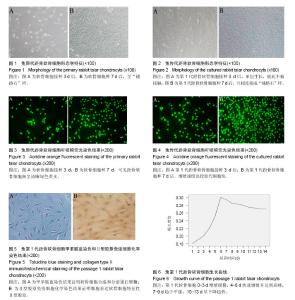| [1] 王勇平,朱兆金,徐向阳.距骨骨软骨损伤研究现状.生物骨科材料与临床研究,2016,13(3):63-66.[2] Looze CA, Capo J, Ryan MK, et al. Evaluation and management of osteochondral lesions of the talus. Nehrer S, Vannini F, eds. Cartilage. 2017; 8(1): 19-30. [3] Prado MP, Kennedy JG, Raduan F, et al. Diagnosis and treatment of osteochondral lesions of the ankle: current concepts. Revista Brasileira de Ortopedia.2016; 51(5): 489-500. [4] Gianakos AL, Yasui Y, Hannon CP, et al. Current management of talar osteochondral lesions. World J Orthop. 2017;8(1):12-20. [5] Baums MH, Schultz W, Kostuj T, et al. Cartilage repair techniques of the talus: An update. World J Orthop .2014; 5(3): 171-179. [6] Badekas T, Takvorian M, Souras N. Treatment principles for osteochondral lesions in foot and ankle. International Orthopaedics. 2013;37(9): 1697-1706. [7] Zengerink M, Struijs PAA, Tol JL, et al. Treatment of osteochondral lesions of the talus: a systematic review. Knee Surgery, Sports Traumatology, Arthroscopy. 2010;18(2): 238-246. [8] Ferkel RD, Scranton PE Jr, Stone JW, et al. Surgical treatment of osteochondral lesions of the talus. Instr Course Lect.2013;59: 387-404.[9] Reilingh ML, van Bergen CJA, Blankevoort L, et al. Computed tomography analysis of osteochondral defects of the talus after arthroscopic debridement and microfracture. Knee Surgery, Sports Traumatology, Arthroscopy. 2016, 24:1286-1292. [10] Saltzman BM, Lin J, Lee S. Particulated Juvenile Articular Cartilage Allograft Transplantation for Osteochondral Talar Lesions. Nehrer S, Vannini F, eds. Cartilage. 2017, 8(1): 61-72. [11] 王双利,潘政军,江华,等. 距骨骨软骨损伤手术治疗的研究进展[J]. 中华解剖与临床杂志,2016,21(2):172-175.[12] 陈俊峰,张家兴,黄剑伟. 踝关节镜下自体骨软骨移植术和微骨折手术治疗距骨骨软骨损伤比较[J]. 现代医院, 2016,16(3): 356-358.[13] 肖裕春,赵建国,袁涛,等.自体骨软骨移植治疗距骨骨软骨损伤疗效分析[J].实用骨科杂志,2014,20(12):1092-1095.[14] Becher C, Zühlke D, Plaas C, et al. T2 -mapping at 3 T after microfracture in the treatment of osteochondral defects of the talus at an average follow-up of 8 years. Knee Surg Sports Traumatol Arthrosc.2015;23(8):2406-2412.[15] Yasui Y, Wollstein A, Murawski CD, et al. Operative treatment for osteochondral lesions of the talus: biologics and scaffold-based therapy. Cartilage. 2017;8(1):42-49. [16] Seo SJ, Mahapatra C, Singh RK, et al. Strategies for osteochondral repair: Focus on scaffolds. Journal of Tissue Engineering. 2014;5:1-14.[17] Phull AR, Eo SH, Abbas Q, et al. Applications of chondrocyte based cartilage engineering: An overview. BioMed Research International. 2016;2016:1-17. [18] Zhong L, Huang X, Karperien M, et al. The Regulatory Role of Signaling Crosstalk in Hypertrophy of MSCs and Human Articular Chondrocytes. Int J Mol Sci. 2015;16(8): 19225-19247. [19] 孙安科,裴国献.软骨组织工程种子细胞的来源、培养和评价[J]. 国外医学:生物医学工程分册,2003,26(4):179-183.[20] 刘小荣,张笠,高武,等.新西兰兔关节软骨细胞分离培养与鉴定的实验研究[J].国际检验医学杂志,2012,33(19):2307-2308.[21] 王勇平,蒋垚.软骨细胞体外培养及鉴定[J].生物骨科材料与临床研究,2012,9(4):33-35.[22] Danisovic L, Varga I, Zamborsky R, et al. The tissue engineering of articular cartilage: cells, scaffolds and stimulating factors. Exp Biol Med (Maywood). 2012;237(1): 10-17.[23] 关炼雄,段莉,黄江,等. 软骨细胞去分化研究进展[J].国际骨科学杂志,2014,35(4):250-253.[24] The Ministry of Science and Technology of the People’ s Republic of China. Guidance suggestions for the care and use of laboratory animals.2006-09-30.[25] 赵海洋,马子君,路屹,等.兔关节软骨细胞原代培养及生物学鉴定[J].中国老年学杂志,2015,35(4):1049-1051.[26] 叶蕻芝,李西海,梁文娜,等.软骨细胞体外分离培养与鉴定的实验研究[J].福建中医学院学报,2008,18(6):32-37.[27] 李兵,吴志宏,刘广源,等.三种软骨细胞分离培养方法对细胞骨架影响的比较[J].中华实验外科杂志,2007,24(9):1108-1110.[28] 匡世军,刘志光,何一青,等.兔颞下颌距骨盘纤维软骨细胞分离培养的实验研究[J].中山大学学报:医学科学版, 2006, 27(3): 318-321.[29] 张志光,郑卫平,苏凯.兔关节软骨细胞的分离、培养和形态学特征[J].中山大学学报:医学科学版,2004,25(1): 63-66.[30] Chockalingam PS, Varadarajan U, Sheldon R, et al. Involvement of protein kinase Czeta in interleukin-1beta induction of ADAMTS-4 and type 2 nitric oxide synthase via NF-kappa B signaling in primary human osteoarthritic chondrocytes. Arthritis Rheum.2007;56(12): 4074-4083.[31] Ho LJ, Lin LC, Hung LF, et al. Retinoic acid blocks pro-inflammatory cytokine-induced matrix metalloproteinase production by down-regulating JNK-AP-1 signaling in human chondrocytes. Biochem Pharmacol. 2005;70(2): 200-208.[32] 刘雷,韦庆军,陈管雄,等. 乳兔关节软骨细胞的分离、培养及生物学特性的观察[J].广西医科大学学报,2014,31(3):364-368.[33] Ryu JH, Chun JS. Opposing roles of WNT-5A and WNT-11 in interleukin-1beta regulation of type II collagen expression in articular chondrocytes.J Biol Chem. 2006;281(31): 22039-22047.[34] 张莉,郭全义,眭翔,等.羊软骨细胞在生物反应器中的培养和扩增[J].中国矫形外科杂志,2006,14(6):446-448.[35] Schulze-Tanzil G, Muller RD, Kohl B, et al. Differing in vitro biology of equine, ovine, porcine and human articular chondrocytes derived from the knee joint: an immunomorphological study. Histochem Cell Biol.2009;131(2): 219-229.[36] Fukui N, Ikeda Y, Tanaka N, et al. αvβ5 integrin promotes dedifferentiation of monolayer-cultured articular chondrocytes. Arthritis Rheum.2011;63(7): 1938-1949.[37] Kang SW, Yoo SP, Kim BS. Effect of chondrocyte passage number on histological aspects of tissue-engineered cartilage. Biomed Mater Eng.2007;17(5): 269-276.[38] Ahmed N, Gan L, Nagy A, et al. Cartilage tissue formation using redifferentiated passaged chondrocytes in vitro. Tissue Eng Part A.2009;15(3): 665-673.[39] 王林林,董玉珍.体外兔软骨细胞的分离、培养与鉴定的研究[J].新乡医学院学报,2015,32(4):310-313. |

